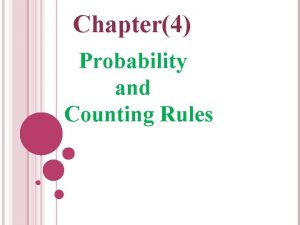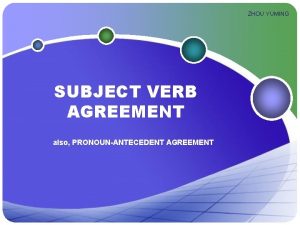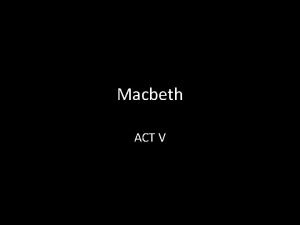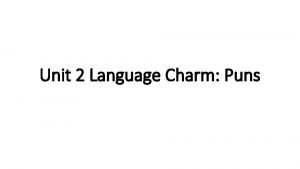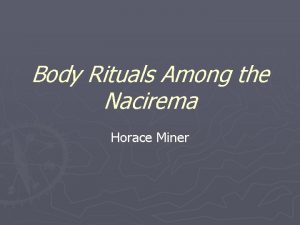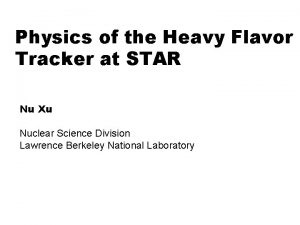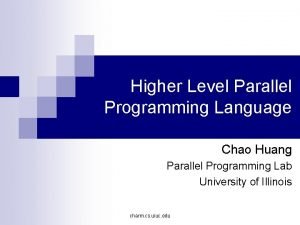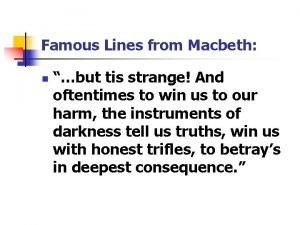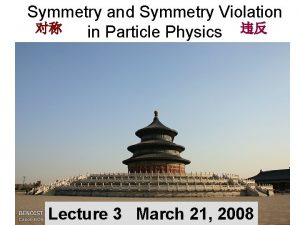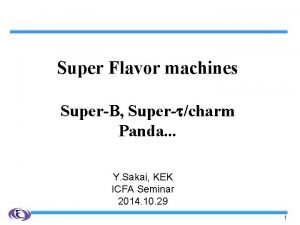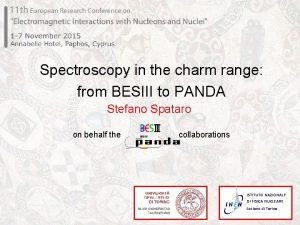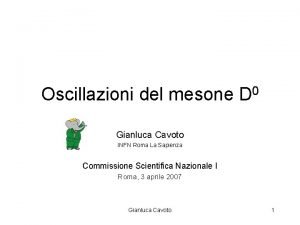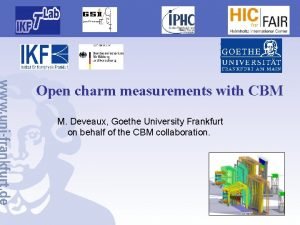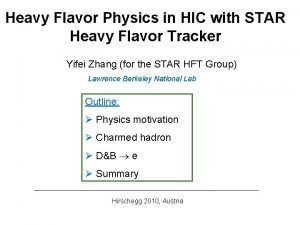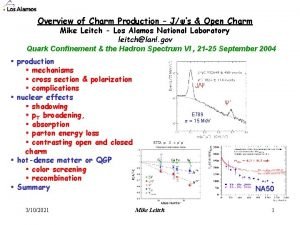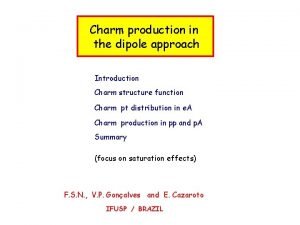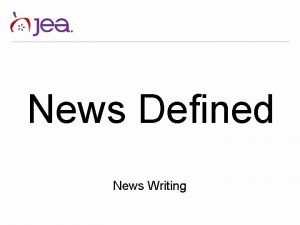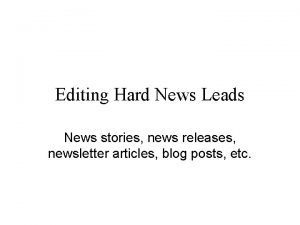News with Charm Introduction Open Charm States with

























- Slides: 25

News with Charm Introduction Open Charm States with hidden Charm Future: PANDA-Detector at FAIR Conclusions H. Koch, L. M. U. and T. U. Munich, Dec. 15, 2005

Introduction (1) Present activities in Hadron Spectroscopy Ba. Bar; BES; BELLE; CLEO; CDF; D , FOCUS, E 835 (Fermilab) Ba. Bar/BELLE/CLEO: Fixed CM-energy ( (4 s)) B-mesons good source for charm BR ≈ 10– 2 (incl. ) Ldt ≈ 400(fb)– 1 (Ba. Bar/BELLE)) H. Koch, L. M. U. and T. U. Munich, Dec. 15, 2005

Introduction (2) BES, CLEO-c : Discrete Energies: J/ , , , . . . e+e– DD e+e– c e+e– qq CDF, D : pp (ECM = 2 Te. V) BB Charm Focus : (200 Ge. V) Be B + X Charm E 791 : –(500 Ge. V)Pt(C) B + X Charm E 835 : pp (Scan mode) J/ , , c, . . . H. Koch, L. M. U. and T. U. Munich, Dec. 15, 2005

Open Charm States (1) D(cq, cq) (q = u, d)-states (BELLE, FOCUS, CDF) Expectation: Two newly discovered broad states: Dπ, D*π-modes M = (2352 ± 50)Me. V ; = (261 ± 50)Me. V D*0(2400)? M = (2427 ± 36)Me. V ; = (384 ± 117)Me. V D 1(2430)? Evidence (BELLE) : B Dππ JP: Compatible with 0+, 1+ Interpretation: Missing cq-states H. Koch, L. M. U. and T. U. Munich, Dec. 15, 2005

Open Charm States (2) Ds(cs, cs)-states (Ba. Bar, CLEO, BELLE, CDF) Expectation: Two newly discovered narrow states 1) M = (2319. 6 ± 0. 2 ± 1. 4)Me. V ; < 3. 8 Me. V! (MModel ≈ 2480 Me. V) Decays: ± Evidence (Ba. Bar). Ds. J*(2317)± Ds π0 H. Koch, L. M. U. and T. U. Munich, Dec. 15, 2005

Open Charm States (3) Quantum numbers: JP = 0+ from B DDs. J* (2317) (BELLE, Angular Distr. ) I = 0 ? No evidence for Ds+π–-, Ds+π+-states 2) M = (2460. 2 ± 0. 8)Me. V ; < 3. 5 Me. V (MModel ≈ 2560 Me. V) Decays: Evidence (Ba. Bar). Ds. J(2460)+ D+s π0 Quantum numbers: JP = 1+ from B DDs. J(2460) (BELLE, Angular Distr. ) Ds I = 0 ? No evidence for Ds+π– H. Koch, L. M. U. and T. U. Munich, Dec. 15, 2005

Open Charm States (4) Interpretation of D*s. J(2317) and Ds. J(2460) 0+, 1+-cq-states: Problem: Masses DK-Molecules Charmed Four Quark States Chiral Multiplets of Heavy-Light Mesons (Eichten, . . . , Novak, Lutz, . . . ) H. Koch, L. M. U. and T. U. Munich, Dec. 15, 2005

States with Hidden Charm (1) Expectation: States below DD-threshold: Much information about J/ , , 0, 1, 2 Very little known about c, , c hc (Spin-Singletts), Important for spin-interaction States above DD-threshold: Many are undetected, lots to do (Heavy Quarkonium Physics, N. Brambilla et al. , CERN Yellow Report; hep-ph/0412158) H. Koch, L. M. U. and T. U. Munich, Dec. 15, 2005

States with Hidden Charm (2) 1 S ) : Rediscovery (BELLE, CLEO, Ba. Bar) (2 0 c BELLE: B K(Ks. K+π–) and e+e– J/ (cc) CLEO/Ba. Bar: -Fusion ( Ks. Kπ) M = (3642. 9 ± 3. 4)Me. V ; < 30 Me. V (Crystal Ball: (3594 ± 5)Me. V) Evidence: Decay modes: Ks. K+π– ? Quantum numbers: JP : Probably 0– I : Probably 0 Mhf(2 s) = (47 ± 4)Me. V, while Mhf(1 s) = (117 ± 1)Me. V ? H. Koch, L. M. U. and T. U. Munich, Dec. 15, 2005

States with Hidden Charm (3) hc (1 1 P 1) CLEO: (2 s) π0 hc π0( c) M = (3524. 4 ± 0. 6 ± 0. 4)Me. V ; < 10 Me. V Evidence (CLEO): Decays: c ? Quantum numbers: JP : Probably 1+ I : Probably 0 Mhf(1 P) = < M( c. J)> - Mhc = (1. 0 ± 0. 6 ± 0. 4)Me. V In agreement with the confinement potential being a Lorentz scalar H. Koch, L. M. U. and T. U. Munich, Dec. 15, 2005

States with Hidden Charm (4) X(3872) (BELLE, CDF, D ; Ba. Bar, BES) M = (3871. 5 ± 0. 4)Me. V ; < 2. 3 Me. V!! Evidence (BELLE): B± K±(J/ π+π–) Decays: J/ π+π– (dominant) (J/ ? ) J/ (1 bin effect) C = +1 J/ π+π–π0 (J/ ? ) D 0 π 0 c. J Production: Quantum numbers: JPC = ? BELLE: Angular distributions of J/ Preference for JPC = 1++ I=0? Ba. Bar: Search for B– K 0 X– K 0(J/ –) ; B 0 K±X (B < 5 x 10– 4) ± H. Koch, L. M. U. and T. U. Munich, Dec. 15, 2005

States with Hidden Charm (5) X(3872) (contin. ) Nature of X(3872): Ordinary charmonium expected to have radiative decay (X decay into c 1 not observed not expected to decay into J/ H. Koch, L. M. U. and T. U. Munich, Dec. 15, 2005

States with Hidden Charm (6) Diquark - Antidiquark (Maiani et al. ) Neutral states produced in B 0, B+-decays have different masses and rates. Slight experimental evidence. No evidence for charged states s-Wave D 0 D*0 molecule (Braaten, Kusunoki, Swanson, Tornquist) m. D 0 + m. D*0 = (3870. 3 ± 2. 0)Me. V M = (+1. 2 ± 2. 0)Me. V Model predictions: B 0 K 0 X suppressed by one order of magnitude wrt B+ K+X JPC = 1++ is favored (X J/ ) < (X ππJ/ ) H. Koch, L. M. U. and T. U. Munich, Dec. 15, 2005

States with Hidden Charm (7) X(3940) (BELLE, Ba. Bar) M = (3943 ± 6)Me. V ; < 52 Me. V Evidence (BELLE): e+e– J/ (cc) Quantum numbers: I, JPC = ? Nature: ? Decays: Y(3940) (BELLE, Ba. Bar) M = (3943 ± 11 ± 13)Me. V ; = (87 ± 22)Me. V Evidence (BELLE): B K( J/ ) Quantum numbers: JPC = ? I=0 Nature: (ccg)-Hybrid? Decays: H. Koch, L. M. U. and T. U. Munich, Dec. 15, 2005

States with Hidden Charm (8) Z(3940) (BELLE, Ba. Bar) M = (3931 ± 4 ± 2)Me. V ; = (20 ± 8 ± 3)Me. V Evidence (BELLE): e+e–( ) ; DD Quantum numbers: JPC = ? Nature: c 2 (2 3 P 2)? Decays: (4260) (Ba. Bar) +6 M = (4259 ± 8+2 – 6 )Me. V ; = (88 ± 23– 4 )Me. V Evidence (Ba. Bar): e+e– (e+e–) ; e+e– π+π–J/ (ISR) Quantum numbers: JPC = 1 -I =? Nature: 1 --- cc-resonance? Decays: H. Koch, L. M. U. and T. U. Munich, Dec. 15, 2005

Future Perspectives (1) Ba. Bar: BELLE: CLEO: BES: COMPASS: PANDA: Super B-Factory: H. Koch, L. M. U. and T. U. Munich, Dec. 15, 2005

Future Perspectives (2) FAIR-Project at GSI Primary Beams • 1012/s; 1. 5 Ge. V/u; 238 U 28+ • 1010/s 238 U 73+ up to 35 Ge. V/u • 3 x 1013/s 30 Ge. V protons Secondary Beams • Broad range of radioactive beams up to 1. 5 - 2 Ge. V/u; up to factor 10 000 in intensity over present • Antiprotons 3 (0) - 30 Ge. V Storage and Cooler Rings • Radioactive beams • 1011 stored and cooled 1 - 15 Ge. V/c antiprotons H. Koch, L. M. U. and T. U. Munich, Dec. 15, 2005

Future Perspectives (3) Antiprotons at FAIR HESR: General Purpose Detector: PANDA Formation: p(scan)p X . . . Production: p(fixed )p X + nπ +. . . PANDA-Collaboration: 370 scientists from 8 countries and 30 institutions H. Koch, L. M. U. and T. U. Munich, Dec. 15, 2005

Future Perspectives (4) QCD systems to be studied with PANDA Rates H. Koch, L. M. U. and T. U. Munich, Dec. 15, 2005

Future Perspectives (5) Physics Program Charmonium Search for new states above DD-threshold Precision determination of masses and widths (Extremly high masses resolution 20 ke. V) Production cross sections Decay branching ratios Exotica Glueballs, Charmed Hybrids, Multiquark states Predictions for Glueballs Prediction for Charmed Hybrids Lowest energy states: 3. 9 - 4. 5 Ge. V Ground state: JPC = 1–+ (Spin exotic!) Widths: Could by narrow in some cases (≈ Me. V) H. Koch, L. M. U. and T. U. Munich, Dec. 15, 2005

Future Perspectives (6) Open Charm Physics Widths of states e. g. : pp Ds. J* (2317) D*s. J(2317) H. Koch, L. M. U. and T. U. Munich, Dec. 15, 2005

Future Perspectives (7) Hadrons in matter Hypernuclear Physics p(3 Ge. V/c)p – (slow) – (fast) – p (inside nucleus) Further Options Baryon Spectroscopy CP-Violation in D-decays Deeply Virtual Compton Scattering (DVCS) Proton FF in time-like region Not discussed: Low energy p-physics: H, Antiprotonic Atoms, p 4 He H. Koch, L. M. U. and T. U. Munich, Dec. 15, 2005

Future Perspectives (8) Merits of Antiprotons In pp-annihilation all qq-states can be formed directly (not only JPC = 1 --) High mass resolution for all states (≈ 20 ke. V) pp cross sections high Data with very high statistics H. Koch, L. M. U. and T. U. Munich, Dec. 15, 2005

Future Perspectives (9) High probability for production of exotic states Example: Crystal Barrel @ LEAR; Spin exotic states (JPC = 1 -+) at 1400/1600 Me. V Low final state multiplicities Clean spectra, good for PWA analyses H. Koch, L. M. U. and T. U. Munich, Dec. 15, 2005

Conclusions Hadron Spectroscopy is in the focus of interest again Experimental developments Lots to be expected from further running of Ba. Bar, BELLE, CLEO, BES, COMPASS, . . . New and very precise data to be expected from PANDA/GSI Theoretical developments Lattice QCD Effective Field Theories Chiral calculations H. Koch, L. M. U. and T. U. Munich, Dec. 15, 2005
 영국 beis
영국 beis What are hard news
What are hard news Chapter 4 probability and counting rules
Chapter 4 probability and counting rules All that glitters ______ not gold
All that glitters ______ not gold Charm and grace
Charm and grace Despair thy charm and let the angel
Despair thy charm and let the angel Special charm or appeal
Special charm or appeal Language
Language Forbid it lord that i should boast
Forbid it lord that i should boast Who are the holy mouth men
Who are the holy mouth men Reducio charm
Reducio charm Charm mesom
Charm mesom Charm programming language
Charm programming language Avaunt and quit my sight
Avaunt and quit my sight It has its charm
It has its charm Ffa charm
Ffa charm A charm quark has a charge of approximately
A charm quark has a charge of approximately Virtual production
Virtual production Ombesito
Ombesito Gianluca cavoto
Gianluca cavoto Charm
Charm Heavy flavor physics
Heavy flavor physics Golden butterfly awards 2018 winners
Golden butterfly awards 2018 winners What were the 11 free states
What were the 11 free states Southern vs northern states
Southern vs northern states Checks and balances dbq
Checks and balances dbq


